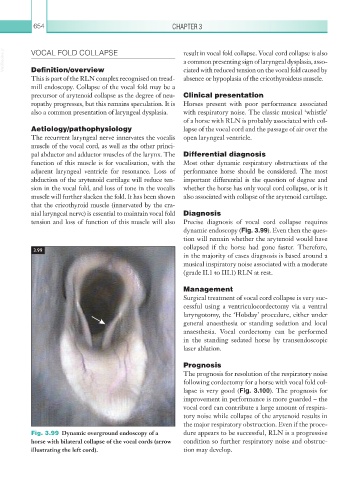Page 679 - Equine Clinical Medicine, Surgery and Reproduction, 2nd Edition
P. 679
654 CHAPTER 3
VetBooks.ir VOCAL FOLD COLLAPSE result in vocal fold collapse. Vocal cord collapse is also
a common presenting sign of laryngeal dysplasia, asso-
Definition/overview
This is part of the RLN complex recognised on tread- ciated with reduced tension on the vocal fold caused by
absence or hypoplasia of the cricothyroideus muscle.
mill endoscopy. Collapse of the vocal fold may be a
precursor of arytenoid collapse as the degree of neu- Clinical presentation
ropathy progresses, but this remains speculation. It is Horses present with poor performance associated
also a common presentation of laryngeal dysplasia. with respiratory noise. The classic musical ‘whistle’
of a horse with RLN is probably associated with col-
Aetiology/pathophysiology lapse of the vocal cord and the passage of air over the
The recurrent laryngeal nerve innervates the vocalis open laryngeal ventricle.
muscle of the vocal cord, as well as the other princi-
pal abductor and adductor muscles of the larynx. The Differential diagnosis
function of this muscle is for vocalisation, with the Most other dynamic respiratory obstructions of the
adjacent laryngeal ventricle for resonance. Loss of performance horse should be considered. The most
abduction of the arytenoid cartilage will reduce ten- important differential is the question of degree and
sion in the vocal fold, and loss of tone in the vocalis whether the horse has only vocal cord collapse, or is it
muscle will further slacken the fold. It has been shown also associated with collapse of the arytenoid cartilage.
that the cricothyroid muscle (innervated by the cra-
nial laryngeal nerve) is essential to maintain vocal fold Diagnosis
tension and loss of function of this muscle will also Precise diagnosis of vocal cord collapse requires
dynamic endoscopy (Fig. 3.99). Even then the ques-
tion will remain whether the arytenoid would have
collapsed if the horse had gone faster. Therefore,
3.99
in the majority of cases diagnosis is based around a
musical inspiratory noise associated with a moderate
(grade II.1 to III.1) RLN at rest.
Management
Surgical treatment of vocal cord collapse is very suc-
cessful using a ventriculocordectomy via a ventral
laryngotomy, the ‘Hobday’ procedure, either under
general anaesthesia or standing sedation and local
anaesthesia. Vocal cordectomy can be performed
in the standing sedated horse by transendoscopic
laser ablation.
Prognosis
The prognosis for resolution of the respiratory noise
following cordectomy for a horse with vocal fold col-
lapse is very good (Fig. 3.100). The prognosis for
improvement in performance is more guarded – the
vocal cord can contribute a large amount of respira-
tory noise while collapse of the arytenoid results in
the major respiratory obstruction. Even if the proce-
Fig. 3.99 Dynamic overground endoscopy of a dure appears to be successful, RLN is a progressive
horse with bilateral collapse of the vocal cords (arrow condition so further respiratory noise and obstruc-
illustrating the left cord). tion may develop.

